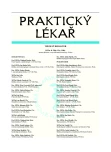Evolution and evolutionary theory for physicians.
I. Fact. Theory. Method.
Authors:
F. Koukolík
Authors‘ workplace:
Primář: MUDr. František Koukolík DrSc.
; Národní referenční laboratoř prionových chorob
; Fakultní Thomayerova nemocnice s poliklinikou, Praha
; Oddělení patologie a molekulární medicíny
Published in:
Prakt. Lék. 2010; 90(1): 3-5
Category:
Editorial
Overview
The year 2009 was Darwin’s anniversary year:
Charles Darwin was born 1809 and his most famous book „On the origin of species by means of natural selection“ appeared 1859. The collection of upcoming papers, this one is the first, will attempt to describe what biological evolution and evolutionary theory means, outline its history and pin point what physicians should probably know about evolution and evolutionary theory. If we accept the proposition: “evolution is the fact and evolutionary theory is its explanation”, we must define the terms scientific fact and scientific theory in order to prevent misunderstandings. Darwin’s working method is outlined.
Key words:
Darwin, biological evolution, evolutionary theory, scientific fact, scientific theory, Darwin’s method
Sources
1. Adams, M.D., Dubnick, M., Kerlavage, A.R. et al. Sequence identification of 2 375 human brain genes. Nature, 1992, 335, p. 632-634.
2. Ayala, J.F. Darwin and the scientific method. Proc. Natl. Acad. Sci. USA 2009, 106, p. 10033-10039.
3. Ayala, J.F. On the scientific method. Hist. Phil. Life. Sci. 1994, 16, p. 205-240.
4. Barlow, N. The autobiography of Charles Darwin. London: Collins, 1958.
5. Darwin, Ch. 1859/1953 O vzniku druhů přírodním výběrem nebo uchováním prospěšných plemen v boji o život. Praha: NČSAV, 1953, přel. E. Hadač, A. Hadačová.
6. Kompletní dílo Charlese Darwina [on-line]. Dostupné na http://darwin-online.org.uk/.
7. Šest vydání knihy O vzniku druhů přírodním výběrem [on-line]. Dostupné na http://darwin.online.org.uk/contents.html#origin.
8. Dobzhansky, T. Nothing in biology makes sense except in the light of evolution. Am. Biol. Teach. 1973, 35, p. 125-129.
9. Gower, B. Scientific method a historical and philosophical introduction. Oxford: Routledge, 1997.
10. Hempel, C.G. Aspects of scientific explanation. New York: Free Press, 1965.
11. Hawking, S. A Brief History of Time. New York: Bantam Books, 1998. Česky: Stručná historie času. Praha: Nakladatelství Dokořán, 2007.
12. Hempel, C.G. Problems and changes in the empiricist criterion of meaning. In: Linsky L. Semantics and the Philosophy of Language. Urbana: University of Illinois Press, 1951, p. 163.
13. Kitcher, P. Abusing science: the case against creationism. Cambridge: MIT Press, 1982.
14. Koukolík, F., Drtilová, J. Základy stupidologie (Život s deprivanty II). Praha: Galén, 2002, s. 192-201.
15. Kuhn, T. The structure of scientific revolutions. Chicago: University of Chicago Press, 1962.
16. Moore, B.N., Parker, N. Critical thinking. 6th ed. New York: McGraw-Hill, 2001.
17. Popper, K. The logic of scientific discovery. London: Hutchinson, 1959.
18. Popper, K. Conjectures and refutations. London: Routledge and Kegan Paul, 1963, p. 33-39.
19. Schick, T. (ed). Readings in the philosophy of science. Mountain View, California: Mayfield, 2000, p. 9-13.
20. Popper, K. Natural selection and the emergence of mind. Dialectica 1978, 32, p. 339–355.
21. Quine, W.V.O. Two dogmas of empiricism. From a logical point of view. Cambridge: Harvard University Press, 1952.
22. Ravetz, J.R. Scientific knowledge and its social problems. New Brunswick: Transactions Publishers, 1996.
23. Ravetz, J.R. A no-nonsense guide to science. Oxford: New Internationalist, 2005.
24. Random House Webster´s unabridged dictionary, 2nd ed. New York: Random House, 1999.
Labels
General practitioner for children and adolescents General practitioner for adultsArticle was published in
General Practitioner

2010 Issue 1
Most read in this issue
- Mallet finger
- Food craving: Food-Craving Questionnaire – Trait
- Practical application of bright light therapy
- Breast cancer in older women
